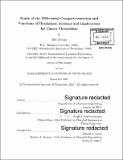| dc.contributor.advisor | Gregory Stephanopoulos. | en_US |
| dc.contributor.author | Zhang, Zhe, Ph. D. Massachusetts Institute of Technology | en_US |
| dc.contributor.other | Massachusetts Institute of Technology. Department of Chemical Engineering. | en_US |
| dc.date.accessioned | 2018-03-27T14:16:57Z | |
| dc.date.available | 2018-03-27T14:16:57Z | |
| dc.date.copyright | 2017 | en_US |
| dc.date.issued | 2017 | en_US |
| dc.identifier.uri | http://hdl.handle.net/1721.1/114311 | |
| dc.description | Thesis: Ph. D., Massachusetts Institute of Technology, Department of Chemical Engineering, 2017. | en_US |
| dc.description | Cataloged from PDF version of thesis. | en_US |
| dc.description | Includes bibliographical references. | en_US |
| dc.description.abstract | Selectivity is a very important consideration when designing cancer treatment. Therefore, targeting cancer-specific isoforms of key metabolic enzymes is a very promising strategy. Elevated glucose consumption and lactate secretion under aerobic conditions is a hallmark of many cancer cells. One of the major contributors to this highly glycolytic phenotype is hexokinase 2 isoform (HK2), which is significantly overexpressed in many tumors but not in normal adult tissue. Several small molecule inhibitors targeting HK have exhibited promising anticancer activity. However, these small molecule inhibitors cannot differentiate between HK isoforms, leading to severe side effects. Elucidating the differences between HK isoforms can guide us in designing isoform-specific inhibitors. Moreover, the complexity and robustness of cellular metabolism and the intricate mechanism underlying cancer development and progression make it very difficult to effectively treat cancer by targeting a single metabolic enzyme. Improved understanding of the metabolic effects of HK to cancer can guide us in identifying selective targets and designing effective combination therapies. We first studied the differential subcellular localizations of HKl and HK2 by selective permeabilization and cell fractionation. We then characterized the metabolic functions of HK for cell growth and proliferation using stable isotope labeling and metabolic flux analysis. Key findings were verified in a hepatocellular carcinoma cell line using low glucose feeding or HK inhibitor. These experiments identified differential HK enzymatic activity in different cell compartments, and discovered key metabolic pathways co-regulated with glycolysis via cellular redox status. These findings may provide guidance in designing cancer-specific inhibitors or combination therapy targeting multiple synergistic metabolic pathways. | en_US |
| dc.description.statementofresponsibility | by Zhe Zhang. | en_US |
| dc.format.extent | 231 pages | en_US |
| dc.language.iso | eng | en_US |
| dc.publisher | Massachusetts Institute of Technology | en_US |
| dc.rights | MIT theses are protected by copyright. They may be viewed, downloaded, or printed from this source but further reproduction or distribution in any format is prohibited without written permission. | en_US |
| dc.rights.uri | http://dspace.mit.edu/handle/1721.1/7582 | en_US |
| dc.subject | Chemical Engineering. | en_US |
| dc.title | Study of the differential compartmentation and functions of hexokinase isoforms and implications for cancer metabolism | en_US |
| dc.type | Thesis | en_US |
| dc.description.degree | Ph. D. | en_US |
| dc.contributor.department | Massachusetts Institute of Technology. Department of Chemical Engineering | |
| dc.identifier.oclc | 1028735091 | en_US |
